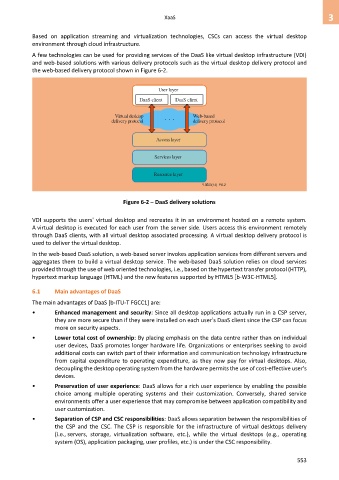Page 561 - Cloud computing: From paradigm to operation
P. 561
XaaS 3
Based on application streaming and virtualization technologies, CSCs can access the virtual desktop
environment through cloud infrastructure.
A few technologies can be used for providing services of the DaaS like virtual desktop infrastructure (VDI)
and web-based solutions with various delivery protocols such as the virtual desktop delivery protocol and
the web-based delivery protocol shown in Figure 6-2.
User layer
DaaS client DaaS client
Virtual desktop . . . Web-based
delivery protocol delivery protocol
Access layer
Services layer
Resource layer
Y.3503(14)_F6-2
Figure 6-2 – DaaS delivery solutions
VDI supports the users' virtual desktop and recreates it in an environment hosted on a remote system.
A virtual desktop is executed for each user from the server side. Users access this environment remotely
through DaaS clients, with all virtual desktop associated processing. A virtual desktop delivery protocol is
used to deliver the virtual desktop.
In the web-based DaaS solution, a web-based server invokes application services from different servers and
aggregates them to build a virtual desktop service. The web-based DaaS solution relies on cloud services
provided through the use of web oriented technologies, i.e., based on the hypertext transfer protocol (HTTP),
hypertext markup language (HTML) and the new features supported by HTML5 [b-W3C-HTML5].
6.1 Main advantages of DaaS
The main advantages of DaaS [b-ITU-T FGCC1] are:
• Enhanced management and security: Since all desktop applications actually run in a CSP server,
they are more secure than if they were installed on each user's DaaS client since the CSP can focus
more on security aspects.
• Lower total cost of ownership: By placing emphasis on the data centre rather than on individual
user devices, DaaS promotes longer hardware life. Organizations or enterprises seeking to avoid
additional costs can switch part of their information and communication technology infrastructure
from capital expenditure to operating expenditure, as they now pay for virtual desktops. Also,
decoupling the desktop operating system from the hardware permits the use of cost-effective user's
devices.
• Preservation of user experience: DaaS allows for a rich user experience by enabling the possible
choice among multiple operating systems and their customization. Conversely, shared service
environments offer a user experience that may compromise between application compatibility and
user customization.
• Separation of CSP and CSC responsibilities: DaaS allows separation between the responsibilities of
the CSP and the CSC. The CSP is responsible for the infrastructure of virtual desktops delivery
(i.e., servers, storage, virtualization software, etc.), while the virtual desktops (e.g., operating
system (OS), application packaging, user profiles, etc.) is under the CSC responsibility.
553

